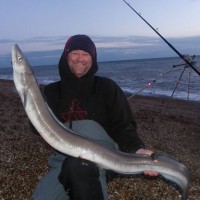What is a Peeler Crab, and how do I collect them? These are two of the most common questions I get asked. and hopefully I will be able to answer those questions in this article.
In my mind there are very few baits that are better than Peeler Crabs. All manner of fish love them, I have caught Rays, Bass, Smoothound and lots of Cod on them. My friend Paul Black had this lovely Bass of almost 12lb on fresh Peeler, so we know that they take big fish.

So what is a Peeler Crab? It is not a specific type of crab, it is any crab that has entered into the moulting process. For a crab to grow it has to shed its old outer shell and produce a new one that it can grow into. As the new shell starts to get bigger then the old shell, the crab pumps itself full of water to force the old shell to crack off. At the same time it produces large amounts of Amino Acids, which will aid in rapidly increasing the size of the new shell and hardening it off. It is believed that it is the release of the Amino Acids that the fish home in on.
When can I collect Peelers? The crabs normally start to moult around mid April and continue to do so until the first frosts of Autumn. However in certain parts of the country like Devon they peel all year round.
I know this may seem obvious to most, but you need low water to be able to find the crabs. The further out it goes, the more chance you have of finding good numbers of crabs.
Where can I find Peeler Crabs? You won’t just be able to drop your crab net down in the harbour and catch Peelers unfortunately. When crabs are moulting they are at their most vulnerable, so they like to find as much shelter and protection as possible.
You can collect them all round the coast including rocks, estuaries and even open beaches. But on open beaches they will be hiding along the edges of groynes and hugging every bit of feature that they can find.
You need to turn over rocks and weed, to see if they are under them. Please return the rocks and weed in the same place and position you found them, and don’t leave them upside down. Lots of tiny invertebrates and micro sources of food live on and around the rocks and plants. If you leave them turned upside down the tide will come in and wash them away.
In the estuaries of Devon and other areas around the country, professional bait collectors set traps, using tyres or sections of drain pipe, which the crabs use to shelter. It is really not a good idea to go robbing these guys traps, there has been know for turf wars to be fought over them. However there are plenty of shelters that crabs find on mud flats, and on these they often bury themselves slightly under the surface. Have a feel around and see if a crab is hiding in there. It is a good idea to wear some form of protective glove.
How do I recognise a Peeler? recognising a peeler is a little bit more difficult. Sometimes it is very obvious as the shell can be seen breaking away from the main body.
 Other times you need to push firmly, but not hard, on the under side of the crab, to feel if it is starting to give. If it is then the crab has started to moult. If you are still unsure then you can grab the first segment of its leg and pull it gently. If it comes off easily then that is also a peeler. The short video that I have made below should help.
Other times you need to push firmly, but not hard, on the under side of the crab, to feel if it is starting to give. If it is then the crab has started to moult. If you are still unsure then you can grab the first segment of its leg and pull it gently. If it comes off easily then that is also a peeler. The short video that I have made below should help.
If you are lucky enough to have gathered a few and now want to know how to rig them then you can look at my other article on How to Rig a Peeler Crab which also contains a video on how to rig them.









Hi Sean, after seeing your brill vid, I now want to go off and forage for my winter’s stash of peeler crabs. Normally I’m a hard core fisherwoman, but after trying to use live peelers this year, I really can’t justify pulling them to bits alive, so can you do a quick vid as to how to despatch them QUICKLY, before I strip them down for the freezer. -Thanks in advance, (not such a hard core fisherwoman after all!) Bridget.
Hi Bridget.
I think it is time that I did a new “How to use Peeler Crab” video, as the quality of the last one is not great.I have found the easiest way to dispatch the crab is to use my scissors and push the blade in between the eyes.
Where can I get some peeler crab??